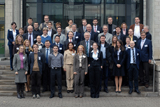Bio-fabrication of Artificial Blood Vessels with Laser Light
Press Release Aug 28, 2015
Thanks to the development of an artificial, three-layered perfused skin model, the EU research project ArtiVasc 3D is advancing into uncharted territories. An interdisciplinary team of researchers led by the Fraunhofer Institute for Laser Technology ILT has developed a 3D printing process for the production of artificial blood vessels out of innovative materials. They have created the foundation to cultivate a full-thickness skin model to a much greater layer thicknesses than previously possible. At the project’s closing event at Fraunhofer ILT from October 28 to 29, 2015, the ArtiVasc 3D researchers will present their findings in detail.
 Fraunhofer Institute for Laser Technology ILT
Fraunhofer Institute for Laser Technology ILT


